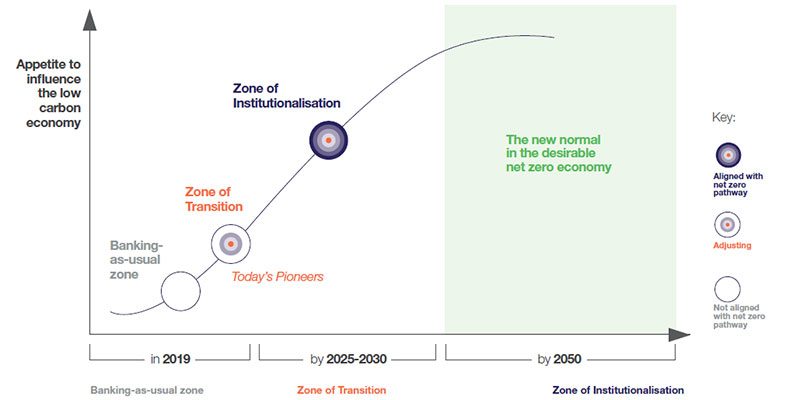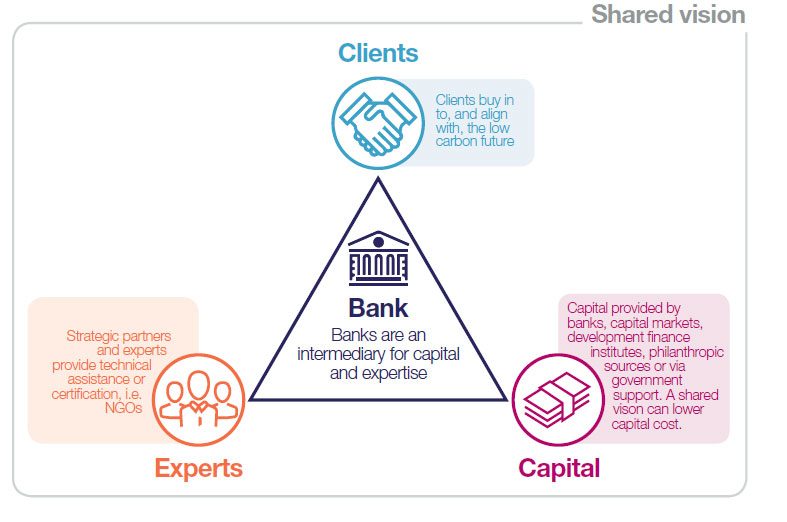A
groundbreaking new report released by the University of Cambridge Institute for
Sustainability Leadership (CISL) – in collaboration with several banks,
including experts from BNP Paribas CIB & Asset Management – sets out to
understand what a “climate-progressive” bank should look like.
With
70% of extreme weather events since 2012 attributed to climate change and
insured losses from natural disasters topping US$130 billion, addressing
climate change is a priority for the banking sector. To achieve the current
2030 climate targets will require €260 billion of extra annual investment
globally – the equivalent of 1.5% of world GDP. How can banks take action to
support net-zero carbon emissions and keep global warming below 1.5°C? What
will it take for banks to move from the current business-as-usual to an active
mindset on clients’ climate transition?
|
Bank 2030 Report findings Through a series of 100 extensive interviews with senior bankers and experts, and analysis of academic and practitioner literature, the researchers found:
|
The banks’ curve of change for a low-carbon economy
The CISL Bank 2030 report assesses the transition curve for banks, identifying how they can move from banking-as-usual to a ‘zone of institutionalisation’ in which their forward-looking, active mindset recognises low-carbon opportunities.The curve of change and roadmap to a low carbon bank of 2030

This trajectory predicts that to move into the ‘zone of transition’ within the next five to 10 years will require greater collaboration with others, including regulators, policymakers and experts. However, the full institutionalisation by banks of a pro-low-carbon economy mindset will require scaled pioneering practices and the alignment of the whole business and operating model with net zero emissions.
Push and pull factors facilitating the low carbon transition
The CISL researchers also analysed pull factors that create opportunities for banks to make a business case for accelerating the transition. These include financing segments of the low-carbon economy that are growth areas, such as the electrification of vehicles and other industries that will experience prominent demand shifts in the coming years.” What will it take for banks to move from the current business-as-usual to an active mindset on transition that incorporates climate risk? ”
Another pull factor is the growth of a low-carbon
pipeline – primarily investment in and financing of low-carbon sectors, which
currently face the so-called “green finance gap”. Several examples of such opportunities
are presented in the report, including the innovative Enel sustainability-linked bond, supported by BNP Paribas sustainable finance teams. The Italian energy company was the first
corporate to issue an SDG-linked bond in which the coupon rate is tied to a key
performance indicator (KPI) about future installed renewable capacity.
The
report also identifies three push factors: pressure from investors, employees
and civil society; legal liability (e.g. parties seeking damages due to losses
linked to climate risk); and the risk of carrying unmeasured and unmanaged
physical and transitional climate risk in portfolios. CISL has developed a Transition Risk Framework for identifying the third of
these risks. The report also highlights how people increasingly see climate
change as a major threat to their country.
Empowering employees to accelerate sustainable finance
A critical step identified by the CISL researchers is the building of capacity and knowledge about sustainability throughout banking teams. This includes empowering relationship managers to focus on pathways towards a low-carbon economy. Several banks see the provision of knowledge about climate change, and how the transition will impact clients, as an essential part of institutionalising sustainable finance. Collaboration outside the financial sector, in particular with experts outside the bank, will be a crucial part of creating a shared vision of the low-carbon economy.
BNP Paribas has been at the forefront of the collaboration and education approach, and since the inception of its sustainable finance programme has built up a network of sustainable finance champions throughout its businesses. In addition, staff in several divisions of the bank – including CIB, Asset Management, Wealth Management – have undertaken an extensive high-impact leadership training programme with CISL, aimed at partnering with experts to embed sustainability knowledge throughout the bank. This ultimately creates a shared vision, and is a key pillar of the bank of the future, as identified by the Bank 2030 report.

